
The Zombies are an English rock band formed in St Albans in 1961. Led by keyboardist/vocalist Rod Argent and vocalist Colin Blunstone, the group had their first British and American hit in 1964 with "She's Not There". In the US, two further singles—"Tell Her No" in 1965 and "Time of the Season" in 1968—were also successful.

Odessey and Oracle is the second studio album by English rock band the Zombies. It was originally released in the UK in April 1968 by CBS Records. The album was recorded primarily between June and August 1967. The sessions took place at EMI and Olympic Studios in London.

Rodney Terence Argent is an English musician. In a career spanning more than 50 years, Argent came to prominence in the mid-1960s as the keyboardist, founder and leader of the rock band the Zombies, and went on to form the band Argent after the first break-up of the Zombies.

Colin Edward Michael Blunstone is an English singer and songwriter. In a career spanning more than 60 years, Blunstone came to prominence in the mid-1960s as the lead singer of the rock band the Zombies, which released four singles that entered the Top 75 charts in the United States during the 1960s: "She's Not There", "Tell Her No", "She's Coming Home" and "Time of the Season". Blunstone began his solo career in 1969, releasing three singles under a pseudonym of Neil MacArthur. Since then, he has released ten studio albums under his real name. He appears on several albums with the Alan Parsons Project and sang "Old and Wise".

"I Wish You Would" is a song recorded by Chicago blues musician Billy Boy Arnold in 1955. It was developed while Arnold was performing with Bo Diddley and incorporates a Diddley-style rhythm. Called "a timeless Chicago blues classic", "I Wish You Would" is Arnold's best-known song and has been recorded by several artists, including the Yardbirds, who recorded it for their debut single in 1964.
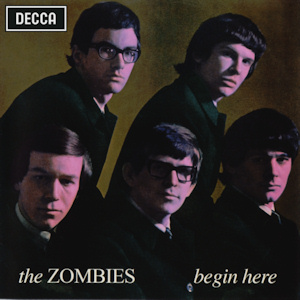
Begin Here is the debut studio album by the English rock band the Zombies, released in April 1965 by Decca Records. The American version repeated many of the tracks from it, but, as was common at the time, deleted some and substituted others.

The Zombies is the debut American studio album by English pop rock band the Zombies, released in January 1965 by Parrot Records. After the success of the double-sided hit single "She's Not There" b/w "You Make Me Feel Good" reached #2 on the U.S. charts in the fall of 1964, Parrot quickly released this LP in 1965. The dozen tracks were taken from material the Zombies cut for their UK debut album, Begin Here. Also included are "It's Alright With Me" and "Sometimes" from their self-titled EP. The album also included their 2nd hit single "Tell Her No".
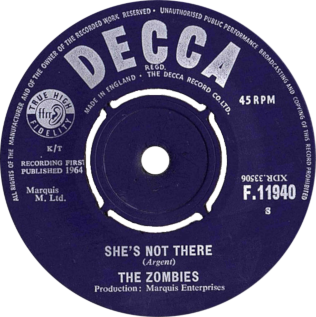
"She's Not There" is the debut single by British rock band the Zombies, written by keyboardist Rod Argent. It reached No. 12 in the UK Singles Chart in September 1964, and No. 2 on the Billboard Hot 100 in the United States at the beginning of December 1964. In Canada, it reached No. 2.

Christopher Taylor White is an English musician. He came to prominence in the mid-1960s as the bass guitarist and occasional lead vocalist of the rock band The Zombies. White is one of the main composers of the Zombies' music, and made major lyrical contributions to the band's songs. He was inducted into the Rock and Roll Hall of Fame in 2019 as a member of the Zombies.
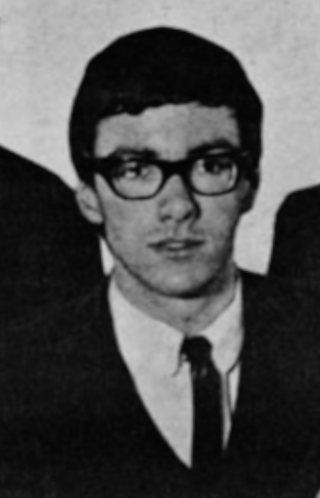
Paul Ashley Warren Atkinson was a British guitarist and record company executive, best known as a founding member of the pop/rock band The Zombies. Atkinson was posthumously inducted into the Rock and Roll Hall of Fame in 2019.

"Goin' Out of My Head" is a song written by Teddy Randazzo and Bobby Weinstein, initially recorded by Little Anthony and the Imperials in 1964. Randazzo, a childhood friend of the group, wrote the song especially for them, having also supplied the group with their previous Top 20 Hit "I'm on the Outside ". Their original version of the song was a Billboard Top 10 Pop smash, reaching No. 6 on the Billboard Hot 100, and No. 1 in the Canadian RPM-list in 1965. The song peaked at No. 8 on Cashbox magazine's R&B chart. The Little Anthony and the Imperials original recording is the best-known version of the song, although it has since been covered by many other artists, including the Zombies, who released a rendition as their last single on Decca Records.

"I Love You" is a 1965 song by the Zombies, written by their bassist Chris White. Written during a tour of France, the song was written at a time the Zombies' mainstream popularity was slowly fading. The song was released as the B-side of Rod Argent's "Whenever You're Ready" to both commercial and critical indifference.

Ennismore is the second solo studio album by the English singer Colin Blunstone of rock band the Zombies. The name of the album comes from Ennismore Gardens, a square in Knightsbridge where Blunstone was living; the name being a variant spelling of the island Inishmore.
Hugh Birch Grundy is an English musician. In a career spanning more than 50 years, Grundy came to prominence in the mid 1960s as the drummer of the English rock band the Zombies. He was inducted into the Rock and Roll Hall of Fame in 2019.
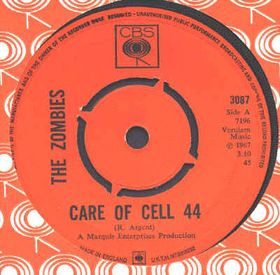
"Care of Cell 44" is a single by the Zombies, from their 1968 album Odessey and Oracle. It was featured on Pitchfork Media's 200 Best Songs of the 1960s list, and has since been covered by modern artists including Elliott Smith and Of Montreal.

"Just Out of Reach" is a song written by singer Colin Blunstone, first recorded by his band the Zombies in 1965. In 1965, it was clear that the Zombies were going to be featured in Otto Preminger's 1966 movie Bunny Lake Is Missing. Therefore, the band had struck a deal with Preminger; he wanted three new songs by the group, recorded in the span of only ten days. During this time, the band's primary songwriters, keyboardist Rod Argent and bassist Chris White suffered somewhat from writer's block. Although White had already managed to come up with two songs, "Remember You" and "Nothing's Changed", the third song was still missing, much to the group's disappointment. Therefore, Blunstone was tasked with the final song.

The Zombies is an extended play 45 rpm record released by the English beat group the Zombies in 1964.
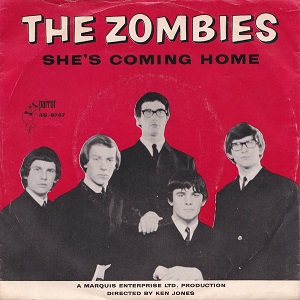
"She's Coming Home" is a song written by keyboardist Rod Argent recorded by his band the Zombies. The song has early origins in Argent's life; he lifted segments from the 1946 song "Magnificat and Nunc dimittis" which he had heard in boy choir. Characterized by its unusual chord progression, the song was recorded on 2 March 1965 during a three-hour session held at Decca Studios along with several other tracks, all of whom were by their standard producer Ken Jones, who knew what Argent had looked for in the song and attempted to produce it in that style.

"I Want You Back Again" is a song written by keyboardist Rod Argent and originally recorded by his band the Zombies. Initially laid down during a session at Decca Studios on 25 November 1964, the group was unsatisfied with the result and the song was not re-recorded until 2 March 1965, together with several other songs. The song largely departs from the soft rock sound of their earlier singles and ventures into jazz rock. Characterized by an unusual rhythmic melody, the song was liked by lead vocalist Colin Blunstone, who didn't like the genre.

"Whenever You're Ready" is a song written by English keyboardist Rod Argent, first recorded by his band the Zombies. Following an American tour in April 1965 supporting their then single "She's Coming Home", the band were disappointed in finding out it had been a chart failure. After the follow-up "I Want You Back Again" was an even less commercial song, pressure from the group's management came forward in order for them to write a commercial song in the style of their earlier singles, which had been hits.






















